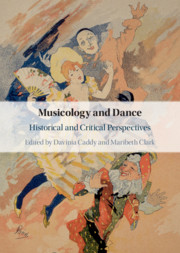Book contents
- Musicology and Dance
- Musicology and Dance
- Copyright page
- Contents
- Figures
- Tables
- Music Examples
- Contributors
- Acknowledgements
- Introduction
- Part I Conceptual Studies
- Part II Case Histories
- Chapter 5 The ‘Splendid and Shameful Art’: Dancing in and around the Wagnerian Gesamtkunstwerk
- Chapter 6 Hymnody, Dance and the Sacred in the Illustrated Song
- Chapter 7 Pavanes and Passepieds in the Age of the Cancan
- Part III Critical Readings
- Select Bibliography
- Index
Chapter 7 - Pavanes and Passepieds in the Age of the Cancan
from Part II - Case Histories
Published online by Cambridge University Press: 09 September 2020
- Musicology and Dance
- Musicology and Dance
- Copyright page
- Contents
- Figures
- Tables
- Music Examples
- Contributors
- Acknowledgements
- Introduction
- Part I Conceptual Studies
- Part II Case Histories
- Chapter 5 The ‘Splendid and Shameful Art’: Dancing in and around the Wagnerian Gesamtkunstwerk
- Chapter 6 Hymnody, Dance and the Sacred in the Illustrated Song
- Chapter 7 Pavanes and Passepieds in the Age of the Cancan
- Part III Critical Readings
- Select Bibliography
- Index
Summary
While noting the usual scholarly snubbing of ‘excessive’ and ‘insubstantial’ dance tunes, Carlo Caballero explores dance’s significance and popularity – not only with audiences, but also with ‘serious’ composers. Writing about late nineteenth-century French musical culture, Caballero examines a vogue for the sixteenth-century pavane (with reference to examples by Saint-Saëns, Delibes, Fauré, Ravel and Debussy, amongst others), considering how and why the genre of the pavane became emblematic of a constellation of contemporary cultural strains of influence. As Caballero recounts, dance took on new significance during the period, aligned with historical prestige, antique exoticism, the French aristocracy, musical nationalism and modernity itself. Guided by this case history, Caballero reminds us of the cultural embeddedness of both dance and musical practices, and why we need ways of understanding these practices as both socially conditioned and conditioning.
- Type
- Chapter
- Information
- Musicology and DanceHistorical and Critical Perspectives, pp. 172 - 204Publisher: Cambridge University PressPrint publication year: 2020

